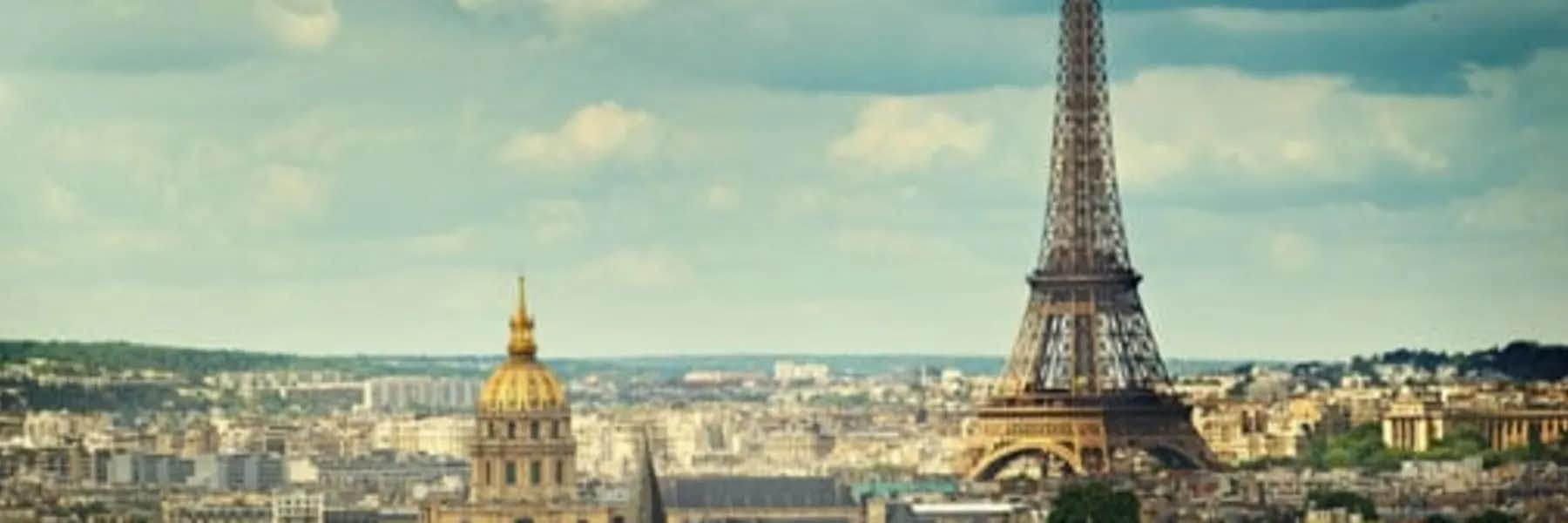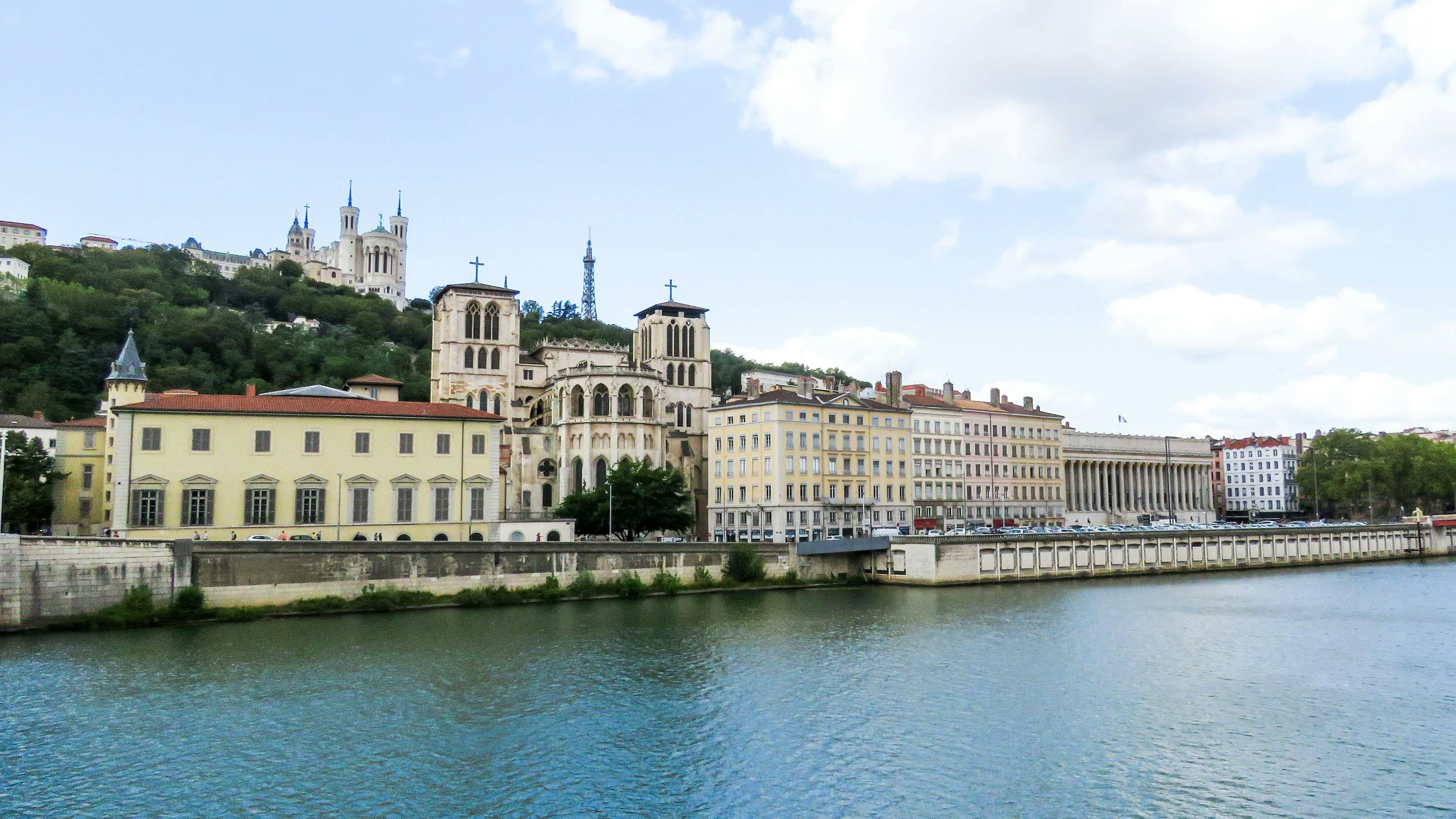France is a country beloved by many, but Paris is the glittering jewel in France’s crown. For millions of people, the City of Light embodies the ultimate in romance, elegance, culture, and all things beautiful and refined. Almost every passion can be indulged here. Whether you’re a history or art buff, a wine fanatic or a fashionista, an impassioned foodie or someone who simply enjoys watching life unfold from a café terrace, you can find your home in Paris.
With an average of 18 million visitors every year, Paris is one of the most visited cities in the world–and one of the most cosmopolitan. Thousands of foreigners resettle in Paris every year, each seeking to drink in the city’s charms and discover what it truly means to live as a Parisian.
Get Your Free France Report Here
Get Your Free France Report Here
Learn more about France and other countries in our daily postcard e-letter. Simply enter your email address below and we’ll send you a FREE REPORT: A Taste of France: All the Ingredients for the Good Life.

By submitting your email address, you will receive a free subscription to IL Postcards, Overseas Dream Home, The Untourist Daily and special offers from International Living and our affiliates. You can unsubscribe at any time, and we encourage you to read more about our Privacy Policy.
Retire in Paris
If your vision of an ideal retirement would be having your pick of a whirl of cultural events, restaurants, and fascinating activities at your fingertips, Paris would be a paradise for you. It is simply impossible to be bored here: nearly every day offers a new museum exhibition, a restaurant or boutique opening, or some fascinating little corner to discover. The city is both timeless and ever-evolving. Your job as a transplanted Parisian is to embrace the richness of the city in all its many flavors.
Being a big city, you won’t need to bother with having a car. Paris has an extensive metro system, a sleek tramway, and a multi-armed network of buses that reach all corners of both the central and suburbs. You can buy a monthly pass for unlimited rides on all public transportation for $90. Seniors are eligible for a discount that varies according to income.
Medical care in Paris is top-notch. The city is home to 39 public hospitals and several private ones. You can easily find English-speaking doctors, whether in the public or private sector, but particularly at the Hertford British Hospital and the American Hospital of Paris, two private hospitals in the Parisian suburbs. Most hospitals have the latest equipment and technology, as well as access to some of the best specialists in Europe.
Americans can be eligible to apply for the national healthcare system if they’ve lived legally in France for three consecutive months and can show that their intent to become legal tax residents of France, living there at least 183 days per year. If you belong to the national system, the amount you pay is roughly 8% of your income over a certain threshold.
If you don’t belong to the national health program, then you must be covered by private insurance to legally live in France. Some expats choose to take a comprehensive hospitalization plan, then pay out-of-pocket for medications and doctor visits. A visit to a general practitioner can be as low as $42.
Lifestyle in Paris
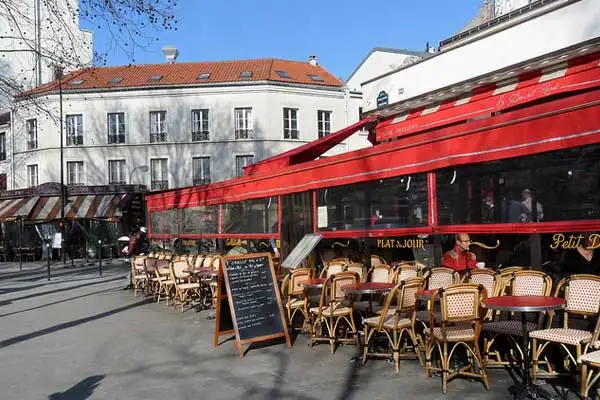
The French are legendary for their enthusiasm for the pursuit of pleasure and relaxation. Even though Paris is high-energy, you’ll still find the rhythm of life more laidback in most major cities. Mealtimes, even weekday lunch breaks, are relaxed enjoyable affairs where food is savored and the company of others appreciated. Weekends are often spent enjoying the charms of the city and the nearby countryside. And locals never hesitate to take full advantage of the five weeks of annual leave allotted to them by law. When you live in Paris, you slip into these easy rhythms as well.
As mentioned above, Paris offers a wealth of fun and fascinating diversions. What makes this even more enjoyable is that there’s a large English-speaking community with whom you can enjoy these activities. There is no shortage of Anglophone meet-up groups for varied interests, from wine-tasting to hiking to traveling.
Speaking of traveling, it’s incredibly easy to explore both France and Western Europe from Paris. Paris’ Charles de Gaulle airport is a main hub for international flights and you can reach numerous major cities–London, Madrid, Florence, Berlin, Geneva, and Lisbon–in less than 90 minutes. Not a fan of flying? Take France’s high-speed train, the TGV. You can be on a beach in the sunny south of France within three hours or eating tapas in Barcelona in six.
Real Estate in Paris
Real estate in Paris is expensive, no question. In the most fashionable neighborhoods in the heart of the city, expect to pay at least $365,000 for a small (398 square foot) one-bedroom place. For better value, look at reasonably central neighborhoods that aren’t as touristy, such as in the 10th arrondissment, near Republique and the Canal St. Martin, or the discreet residential neighborhood in 12th arrondissement near Nation.
Rentals are also pricey but are competitive with many major American cities. Here, you can get a fully furnished, one-bedroom unit with stunning features–floor-to-ceiling windows, hardwood floors, decorative moldings in a classic 19th century building starting from $2,110 per month. A one-bedroom with less classic details may cost around $1,969.
The good news is that very few areas of Paris are considered “unsafe” or otherwise undesirable. What’s more, even if you live at the outer edges of the city, it’s fairly quick and easy to get to almost any central area.
Cost of Living in Paris
The high cost of real estate aside, living in Paris is not as expensive as its reputation would lead you to believe. In 2017, the Mercer Cost of Living Survey ranked Paris as the 50th most expensive city in the world for expats. (For comparison, Sydney ranks 66th, London 19th, Hong Kong 1st, and New York, 6th).
Paris offers countless events and activities that don’t cost a cent. On the first Sunday of every month, all the museums in the city are free. Many popular museums and landmarks, such as Notre Dame Cathedral, Sacre Coeur, and Musée Carnavalet are free year-round. Of course, the best museum of the city is Paris itself. It’s a wonderful thing–and free–to simply stroll around admiring key sites in French history and the city’s beauty.

Eating out also isn’t that expensive. Sure, you’ve got Michelin-starred restaurants such as Tour de l’Argent, that charge eye-watering prices but a two-course lunch in a nice bistro will run about $35 to $40 per couple. Dinner out at a reasonable restaurant will cost around $80 plus wine, but the tab varies widely depending on the neighborhood and how upscale the venue is.
Here’s a sample rundown of the cost of living for a couple per month:
| Expenses | USD |
|---|---|
| Rent | $1,969 |
| Electricity | $54 |
| Gas & Water | $66 |
| Mobile Phone (usually package deal incl. internet, landline, Pay TV etc.) | $60 |
| Groceries | $482 |
| Rental Insurance | $56 |
| Dining Out | $289 |
| Transportation (with unlimited pass) | $90 |
| Entertainment | $231 |
| Total: | $3,317 |
Living It Up in Paris on a Budget
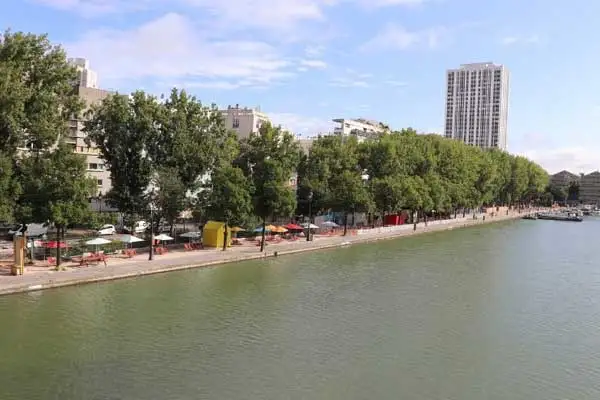
By Mark Probst
We’ve all heard the warnings about traveling to places during high season, the cost of hotels, the cost of airfare, and the cost of attractions and food in tourist areas. For Paris, their most touristed season is the summer months of June to August, when kids are out of school, the weather is sunny and warm, and families can experience the city of lights together and all it has to offer.
So, a spacious apartment on a canal, in the heart of a highly desirable Parisian neighborhood, with a view of the water, and numerous cafés, restaurants, and bars just steps away, sounds pricey. Especially in Paris. Especially during high season.
Well, that’s exactly the place my wife and I rented for a couple of weeks this summer as we enjoyed Paris during peak season, but we didn’t spend hundreds of dollars a night to stay there, our Airbnb was $85 a night, and other places in the neighborhood were even less expensive.
A Hidden Gem on the Water
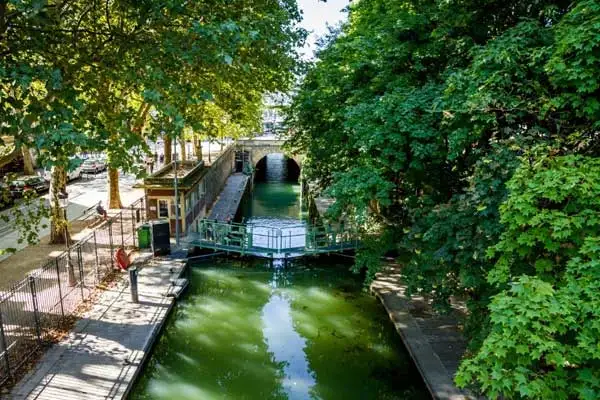
The neighborhood is La Villette, which is located in the northeast part of the capital, in the 19th arrondissement. It’s a hip, pedestrian-friendly neighborhood, where large open green spaces beckon Parisians and tourists alike to get out and enjoy nature in the midst of a busy city.
Parc La Villette is one of the largest parks in Paris and one of the main attractions in the neighborhood. The park hosts many annual events, including an outdoor film festival, and also houses the Philharmonie de Paris, and the Cité des Sciences museum complex.
In addition to the park, La Villette runs along a canal, with lovely pedestrian promenades on both sides. There are separate bike lanes, and numerous places to sit and enjoy the view. The neighborhood has its share of cafesa and bistros along the water, and on the water in the form of two large boats that have been converted to restaurants/bars. There’s also a pretty fabulous brew pub to enjoy.
While we did notice tourists in the neighborhood, the bulk of the people we encountered were locals, and there are many benefits to staying in less-touristy neighborhoods. The price of food when we ate out was less, and it was a huge budget saver to have multiple grocery stores minutes away for meals at home. One of the grocery stores we frequented, Auchan Supermarché, often had the most phenomenal selection of fromage, with a selection of paired wine and champagne above the allotted cheese. Other benefits of staying in a residential neighborhood are being close to everyday amenities that can be harder to find in central tourist areas, like a gym at decent price, a barber shop, and a variety of ethnic foods at a great price.
La Villette was also close to two metro lines, so we could quickly navigate our way into many of the museums and sights we wanted to see.
Summer Fun in the City of Love
There are so many museums we love in Paris, the Louvre, the Pompidou, the Picasso, which just went through a major renovation, but none more than the Musee d’Orsay. Just the building alone, the former grand train station Gare d'Orsay, is worth the trip alone. The Orsay has one of my favorite exhibits on the top floor, impressionist and post-impressionist artists such as Renoir, Monet, Degas, and Van Gogh, and you won’t find a better space and atmosphere to see these great painters and sculptors.
If you find yourself in Paris on the first Sunday of the month, the Orsay and most other museums in Paris are free to get in, but it’s highly recommended you make a reservation online for your free ticket. Another cost-saving way to see this museum is to do the late ticket on Thursday night, which will save you around 25%.

Taking a stroll along the Champs-Élysées , through the Jardin des Champs-Élysées, to the Arc De Triomphe is another one of our favorite things to do in Paris that is absolutely free.
If it’s your first time in the City of Lights, then I recommend making the trek up to the top of the Eiffel Tower. The views are not only unbelievable, but the construction and the history of this iconic tower are worth the price of admission. If you don’t mind walking a small portion of the tower, it will set you back around 20 euros. Since we had been up before, we took a nice stroll around the base of the tower, before finding a nearby café to grab a bite to eat while enjoying its majestic stature.
There are also river cruises along the Seine, including dinner if you want to splurge a bit. We prefer to walk along the Seine, but viewing Paris while cruising on the river is quite unique.
Unfortunately, Notre Dame, the historic medieval Catholic Cathedral, is still undergoing repairs and restoration after the horrific fire that occurred in April of 2019. Even though we weren’t able to go inside this trip, it was still interesting to be able to walk around the restoration site, and read the extensive information they have posted regarding the damage and the repairs they are currently making. In the past, there was a 10 euro charge to enter Notre Dame’s Tower and Crypt, but no charge to enter the cathedral.
The Basilica of Sacré Coeur de Montmartre (Sacred Heart of Montmartre), or just Sacre Couer, is also another must-see, and you’ll get your workout walking Monmartre. Similar to Notre Dame, Sacre Coeur is free to enter, or 8 euros if you want to see the Dome and the Crypt. I also highly recommend the Dali Museum if you’re on Montmartre.
The Meaning of Bon Marche
Aside from eating a certain amount of our meals in our apartment, another great way we love to budget our meal and entertainment costs is by going to markets. Every major city has a central market, often many, and it’s something we seek out every place we travel. Markets are great for the freshest, meat, seafood, and produce, at great prices, but they are also a wonderful spectacle of energy and history that needs to be experienced.
On this trip we visited a few markets, the first being Marches des Enfants Rouges in the Marais. The market, which takes its name from an orphanage that used to be located there in the 16th century, was an exquisite collection of diverse food stalls and restaurants.
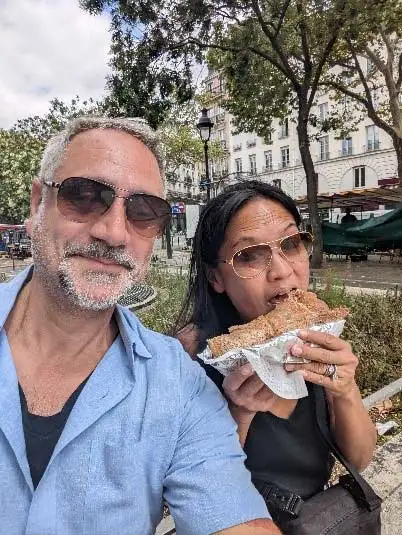
Another market we spent an afternoon perusing was the Paris Open Air Market. Located in the Bastille neighborhood in the 11th arrondissement, the market is a long stretch of stalls selling produce, clothing, shoes, souvenir items, and more. There was also an incredible crepe stall where we had a buckwheat jamon e fromage crepe that was absolutely to die for. It cost us 5 euro and was plenty big enough for us to share.
The third market we took in, and one of the great experiences we had this trip, was making our way to the legendary Paris Flea Market. Located in Porte de Clignancourt, and known to locals as Les Puces (The Fleas), the market is essentially 15 different markets, making up the largest antique market in the world. The Flea market is easy to access from the metro, and is only open on Saturday, Sunday, and Monday. It’s not only a hoot to walk through, but shopping for all budgets is possible, and the street food selection is outstanding.
Bistro Life
In addition to eating at various markets, and street food, we also love eating at local Bistro’s. One of our favorite things to do in Paris is to find an outdoor table at a fun bistro and share a charcuterie plate with a glass of their house wine. It’s not only incredibly satiating, it’s also very entertaining watching the scene unfold in front of us. Paris is one of the best cities in the world to just sit for hours, people watching, and letting the world go by.
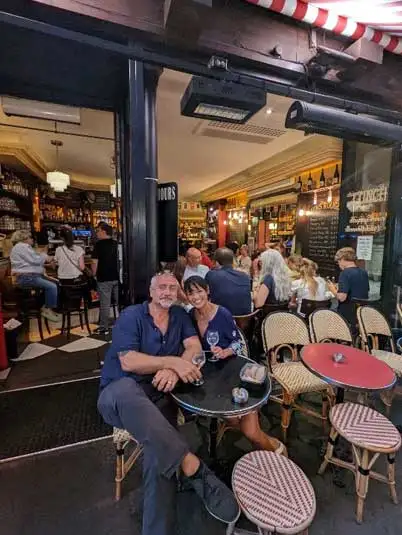
One of our favorite neighborhoods to explore and post up at a good spot is Saint-Germain-Des-Pres, located in the 6th arrondissement. The area is famous for its storied history of writers and artists, such as Voltaire, Rousseau, and Hugo, to name a few, who all spent considerable time in the neighborhood as they changed the world. We love it for its narrow streets, fabulous bistro’s, and window shopping at its perfectly manicured luxury boutiques.
The other spot we end up a lot is Oberkampf. Located in the 11th arrondissement, Oberkampf is a lively area that has everything from hipster pubs and cocktail bars, to live music venues and top-notch restaurants. The neighborhoods are quite different, but they both have great food, and a great scene.
Start Me Up
Being full-time travelers, you can tell it’s important we mind our budget. But it’s also important to us to splurge once in a while. While in Paris we happened to see that the Rolling Stones were in town. Neither one of us had ever seen the legendary rock band, and thought, wow, how cool would be to see them in Paris. After some wrangling online, we secured our tickets (definitely a splurge for us), and we were on our way.
Arriving at the Hipódromo de Longchamp, which is a horse racing track, there was a giant sea of people surrounding a faux six-story Eiffel tower with a huge Stones signature lips logo attached to the side. The stage, with numerous screens and peninsulas was truly extravagant, and the weather couldn’t have been more perfect when 78 years young Mick Jagger and crew took the stage. We sang and danced the Paris night away for over two hours with non-stop hit after hit filling the air. It was such a fun night, and while we did spend more than we wanted to for the tickets, the food, and drinks at the concert were relatively inexpensive.
‘Free Fun’
Anytime we do splurge on tickets or dinner, we re-calibrate the budget with what we call free fun. There are so many things we love doing, especially in picturesque cities like France, that simply cost very little, or no money at all. Walks along the Seine, picnics in the park, visiting markets, going to museums, or just sitting on our balcony enjoying some amazing fromage with a glass of wine, are all activities we love doing and are very cost efficient.
Many nights in La Villette, we would walk along the canal to the park, where Parisians of all ages were setting up after a long hot summer day, packing the grass with blankets or towels to sit on. Many would bring a little charcuterie and a bottle of wine to sit and enjoy the evening as the temperature cooled down.
Another great free activity that occurred that we didn’t plan for, was the Tour de France. We just happened to be in Paris for the last leg, and without actually being aware of the race's finale the day of, we ended up being close to the finish line. We enjoyed the festivities, including a colorful airshow, and the celebration of the winner, Jonas Vingegaard from Denmark.
Who Knew Paris Could Be So Affordable
The sun sets around 9.30 p.m. in Paris in July, and while it can be really hot in the daytime, Parisian summer evenings are absolutely lovely for seeing this great city.
Whether we were enjoying the outdoor lifestyle of our neighborhood, or running all over the city on the metro, we found it very easy to fully enjoy summer in Paris without breaking the bank. There is so much to see and do in Paris, and using the metro to get you around is not only very inexpensive, it’s clean and safe. Depending on how long your stay is, I recommend looking at Metro weekly and monthly passes for additional savings.
It just so happened that the same time we were running around Paris, Ben Affleck and Jennifer Lopez were doing the same on their honeymoon. The city was a buzz with the Bennifer’s in town, and every time we heard about them showing up at the Louvre, or some other spot in Paris we had just visited, my wife and I would joke if they were budgeting their Paris trip similar to us.
While we may not have the same resources as Ben and Jen, we still had an amazing time in Paris on our modest budget, and we didn’t have to deal with one paparazzi.
Climate in Paris
The weather in Paris can be mercurial, with temperatures sometimes dramatically rising and falling within the course of a day. Locals know to wear layers. Still, extreme weather conditions are unusual. Summers tend to be warm with daily temperatures in the mid-to-high 60s F, occasionally reaching into the 80s F. Winters are grey and wet, usually under 50 F but rarely dropping below freezing. Spring, a favorite of romantics, tends to be wet and cool, while autumn is the most ideal time in Paris. There’s usually little rain in September and October and plenty of golden sunshine.
Get Your Free France Report Here
Get Your Free France Report Here
Learn more about France and other countries in our daily postcard e-letter. Simply enter your email address below and we’ll send you a FREE REPORT: A Taste of France: All the Ingredients for the Good Life.

By submitting your email address, you will receive a free subscription to IL Postcards, Overseas Dream Home, The Untourist Daily and special offers from International Living and our affiliates. You can unsubscribe at any time, and we encourage you to read more about our Privacy Policy.
15 Fun and Unusual Things to Do in Paris
By Krystal Kenney
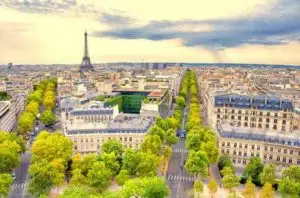
As you may know, Paris is one of the most visited places in the world. Everyone has their top picks for to-dos in Paris usually consisting of climbing to the top of the Eiffel Tower, a coffee in a French cafe, and of course a picnic in a local park with a glass of wine.
As someone who has lived in Paris for almost a decade now, I have my list of stereotypical attractions that most of my friends want to see. But if you are not a first-time visitor or you are someone who enjoys trying something off the beaten travel path this list is for you.
1. Pavillons de Bercy-Musée des Arts Forains
The museum is full of turn-of-the-century wooden carousels that you can still ride today. It was started by Jean-Paul Favand, who spent a lifetime collecting items from fairgrounds, he even rubbed elbows with famous artists including Dali. It’s like taking a step back in time to a 1930s carnival. You will recognize the inside from famous films such as “Midnight in Paris” as well. You can visit the museum by appointment only and it’s well worth a visit for families or adults. Book your visit on their website.
2. Take a 2CV Tour
You may have noticed these adorable little French antique cars on your visit to France. They were first created in 1952 and were a favorite among farmers and later during war times due to their durability and suspension. But now you can take a ride in one in the streets of Paris. Local Parisians strap you in as you cruise around the classic streets of Montmartre or other parts of the city. The driver gives you the history and stops so you can snap a great shot in front of your favorite monument.
3. Ballroom dancing along the Seine
What could be more romantic than dancing next to the Seine at sunset? Salsa, tango, waltz, and swing await you at these little out coves situated along the Seine. Every night at sunset people gather to dance along the water. Many people come to watch, some come to flirt, and some just to randomly discover this fun-filled atmosphere. Locals bring the music. Every evening, starting June 1 through the end of August, dancers gather along the riverbank near the Institut du Monde Arabe, in the Jardin Tino Rossi, just follow the sounds of laughter and music.
4. Visit the Roman Ruins of Paris
If you are visiting the Latin Quarter, you may have passed the crumbling walls of the Roman baths and not even given them a second thought. However, this Abbey and the College of Cluny were built around ancient Roman baths constructed around the 2nd Century. When the baths were discovered in the 12th Century they became part of the Musée Cluny. These Roman baths are some of the most preserved in all of Europe and worth visiting if you want to step back into the Roman way of life long before Paris existed as we know it today.
5. Paris Sewer Museum
Visiting a sewer may not be on the top of your list when it comes to vacation hot spots. But look again because the Paris Sewer Museum is fascinating and does not smell like a sewer. In 1805, Pierre Bruneseau decided to map the ancient and aging sewer system. Even local law enforcement was scared to enter, but Bruneseau was determined, and while down there he discovered jewels, and old dungeons. In 1850, Baron Haussmann and engineer Eugène Belgrand designed the modern Paris sewer system we know today and considered it their gift to Paris. By 1878, the sewer system was over 373 miles long, or the equivalent of the distance from New York to Miami. During the World Exposition of 1867, the sewers were opened to the public to tour and haven’t closed since. Worthy of a visit for its fascinating history and a view of Paris from underneath.
6. Rent an electric boat on the Canal Saint-Martin
This is something not well known to the average tourist. The Canal Saint Martin is a waterway that provided a passageway through Paris for shipments and moving goods. Ornate bridges top the pretty waterways, and in the summer and spring, people can rent small electric boats to cruise along. Pack a bathing suit and picnic, as you look at Paris from the water. The boats are very affordable and anyone can drive them, no license is required. The smallest boat fits five people and some of the larger boats can fit up to 11 people.
7. Pere Lachaise Cemetery
This huge cemetery is home to some of France's most famous personalities and is easily navigated with a free app for your phone. You can visit the graves of Edith Piaf, Frédéric Chopin, Honoré de Balzac, Marcel Proust, Oscar Wilde, Sarah Bernhardt, and Gertrude Stein to name a few. What makes the cemetery so special is not only the people buried there but also the beauty of the ornate headstones and mini chapels delicately placed all along the hilly landscape.
8. Petite Ceinture
This abandoned railway circling the city of Paris is little known by tourists and locals alike. Always free to visit it's an interesting path to stroll with your kids or pet. The railway originally served as a passage for urban travelers from 1862 to 1934 before being abandoned by the city authorities. Built before the metro the “little belt” connected people to the main train stations around Paris. Pieces of it are now overgrown with hundreds of species of flora and fauna, colorful flowers, and greenery against vivid graffiti and street art. Bridges, tunnels, and the original tracks remain mostly untouched, hidden just beyond the streets and neighborhoods of the outer arrondissements. Points of entry on the edges of the 12th, 13th, 14th, 15th, 16th, 17th, 18th, 19th, and 20th arrondissements. Easy access at Villa du Bel Air near Porte de Vincennes.
9. 59 Rivoli
This is a notorious artist squat renovated into legal studios in the heart of Paris not far from the Louvre. The area is known to be very posh but in 1999 a group of artists decided to take over the building and claim it as their own. Even though the space was illegally taken by the artists, it was gaining over 40,000 visitors a year, and in 2001 it was the third most visited center for contemporary art in Paris. Later the city got involved and renovated it, making it more suitable for people to live and work in. It reopened in 2009 with studios for over 30 artists. The six stories of 59 Rivoli and its exhibits are free and open to the public. You can visit on Saturdays and Sundays starting at 6 p.m. and there are free concerts in the ground-floor gallery.
10. Bibliothèque Nationale de France (National Library of France)
This Paris library holds what was once the largest book collection in the world. Even if you can’t read French. The library is well worth a visit. The inside is stunning and just tucked along the Seine. Full of millions of titles, the library also houses French antiques and Greek manuscripts. The most popular attractions inside are Louis XIV’s globes which he kept at Versailles until the French Revolution, but now they call the library home.
11. Dans le Noir?
If you are looking for an unusual restaurant experience, this could be the place for you. Diners eat completely in the dark, which is said to increase gastronomic pleasure and the staff are entirely visually impaired. Diners literally call out their waiter’s names to get service and are given hints on how not to spill and enjoy their meal.
12. Museum of Vampire and Legendary Creatures
This is the only museum of its kind in the world! The founder, Jacques Sirgent, is a self-proclaimed “vampirologist”. He is a scholar on all things vampire-related and has collected fascinating objects over the centuries related to his passion. The most viewed antique is the real “anti-vampire protection kit” that dates back to the 19th century. The kit is designed to fend off creepers in the night. You can also view mummified cats, vampire toys, and spooky books.
13. Go inside the dome of the Sacré-Coeur Basilica
Montmartre is a hot spot for many tourists on their first trip to Paris. And even more so now with Notre Dame closed for visits since the recent fire. Most people venture inside but few climb the 500 steps to the top to take in the amazing views from inside the dome. For a small fee, visitors can climb along the roof of the Basilica and make their way into the dome. What I love about the dome is it’s never busy
14. La Recyclerie
If you are a fan of sustainable living, make your way to this abandoned train station turned into a restaurant and cultural center. Visitors can sit outside in the garden or enjoy the colorful mismatched furniture inside. The center is focused on upcycling and reusing materials whenever possible. They offer an array of activities from theatre, gardening, and concerts. There is always a lot of action happening here and it’s full of locals, if you want to rub elbows with the French.
15. Le Cheese Geek
If you love French cheese and want to learn more about it from a passionate expert this may be the class for you. The class uses exceptional cheeses, pairs them with the best wines, and keeps things lighthearted and fun while learning all about the art of French cheese and how and where it’s made. Classes include geography, tips on pairing, and delicious tasting in a fun and friendly atmosphere.
Get Your Free France Report Here
Get Your Free France Report Here
Learn more about France and other countries in our daily postcard e-letter. Simply enter your email address below and we’ll send you a FREE REPORT: A Taste of France: All the Ingredients for the Good Life.

By submitting your email address, you will receive a free subscription to IL Postcards, Overseas Dream Home, The Untourist Daily and special offers from International Living and our affiliates. You can unsubscribe at any time, and we encourage you to read more about our Privacy Policy.
